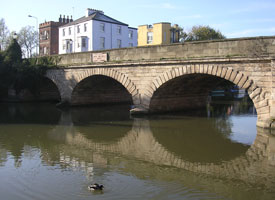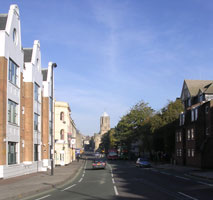| |
| |
| |
| |
| |
| |
ANGLO-SAXON OXFORDSHIRE
Oxford in the Early Anglo-Saxon Period (AD450-650)
During the fifth and sixth centuries there was a concentration of Anglo-Saxon settlement to the south of Oxford, at sites like Abingdon and Sutton Courtenay (Click here to see more of these sites).
Settlement
There is no evidence for an early Anglo-Saxon presence in the centre of Oxford, however the remains of a number of sunken-featured buildings, or grubenhaus, have been found to the south east of the city at Littlemore. Thus suggesting a settlement in the sixth to early seventh centuries.
Burials
A number of burials have also been found to the north and north-east of the city, around the areas of known Roman settlement. During the nineteenth century scattered skeletons were found at the site of the Radcliffe Infirmary, at Kingston Road, north of the University Parks and in Summertown.
River Crossing
 |
 |
Folly Bridge - the current crossing over the River Thames |
St Aldates Road - probably follows the original Anglo-Saxon road. |
Excavations at St Aldates, to the south of the city centre, suggest there may have been an early-mid Anglo-Saxon river crossing at the River Thames. At this time the river covered a wider area than today, having several small islands in its channel.
During the early Anglo-Saxon period, particularly the seventh century, it appears a stone surface was laid on one of these islands to help with crossing the river at St Aldates. Evidence of cattle hoof prints also suggests the river crossing was used for moving cattle.
In the mid Anglo-Saxon period a wooden bridge was constructed at the crossing, between two of the islands. Radiocarbon dating of timbers from this bridge has indicated dates centred around the mid-ninth century (AD850).
There is also archaeological and documentary evidence for human occupation nearby. The crossing continued to be used during the late Anglo-Saxon and early medieval period.